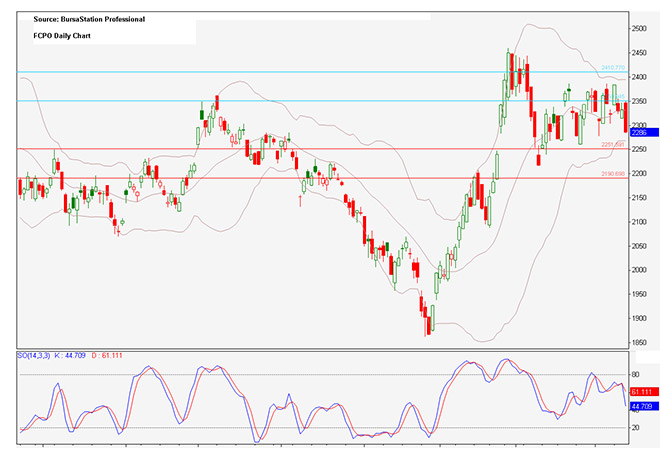 Malaysian palm oil futures edged lower on Friday to 2,286, due to lower-than-expected export data and on high inventories, but the weaker ringgit provided some support.
Malaysian palm oil futures edged lower on Friday to 2,286, due to lower-than-expected export data and on high inventories, but the weaker ringgit provided some support.
Future Crude Palm Oil (FCPO) benchmark January 2015 contract settled at 2,286 on Friday, down 37 points or 1.6 per cent from 2,323 last Friday.
Trading volume decreased to 112,583 contracts from 143,885 contracts from last Monday to Thursday, excluding Tuesday.
Open interest based increased to 589,461 contracts from 584,987 contracts from last Monday to Thursday, excluding Tuesday.
Cargo surveyor, Intertek Testing Services (ITS) reported that exports of Malaysia’s palm oil products during November 1 to 10 decreased 5.3 per cent to 434,862 tonnes compared with 459,379 tonnes during October 1 to 10.
Another cargo surveyor, Societe Generale de Surveillance’s (SGS) report showed that Malaysia’s palm oil exports during November 1 to 10 decreased 3.3 per cent to 450,670 tonnes compared with 465,886 tonnes during October 1 to 10.
A report released by the Malaysian Palm Oil Board (MPOB), showed that palm oil stocks rose to a near 15-year high at the end of October due to a surprise rise in production.
October’s palm oil inventories rose to 2.83 million tonnes, up 7.3 per cent from September, and October’s palm oil production climbed four per cent to 2.03 million tonnes. October’s palm oil exports increased 1.9 per cent to 1.71 million tonnes from September.
Overall, demand strengthened from India, doubling the amount of imports from the previous month, while demand weakened from the EU, China, and the US.
Spot ringgit weakened on Friday to 4.37, as crude prices fell to a near six and a a half-year low, adding to worries about Malaysia’s falling oil and gas revenue.
A trader based in Kuala Lumpur was quoted by Reuters as saying that production in the first 10 days of November from South Peninsula Palm Oil Millers Association (SPPOMA) was lower by 30 per cent, referring to data from the Southern Peninsula Palm Oil Millers’ Association compared with a month earlier, this supported the price until the day end.
Global palm oil output would grow by a million tonnes less than expected in 2016 due to a crop damaging El Nino weather event and haze from Indonesia’s slash-and-burn agricultural practices, analyst Dorab Mistry said.
On Monday, the price rose more than two percent, ending three successive days of decline, due to the weakening ringgit.
On Wednesday, the price declined, by more than one per cent, on an unexpected rise in production and a slightly stronger ringgit.
On Thursday, the price rose, due to a weaker ringgit, while industry data showed that declining production also lent support.
On Friday, the price fell, by almost two per cent to a more than a week low, due to lower-than-expected export data and concerns on oversupply. However, a weakening ringgit provided some support.
Technical analysis
According to the weekly FCPO chart, the price opened above the middle Bollinger band and psychological barrier at 2,300. By the end of the week, the price tested the psychological barrier at 2,300, closing below.
A bearish shooting star candlestick formed, indicating potential to test the middle Bollinger band in near term.
According to the daily FCPO chart, on Monday, the price opened and closed above the middle Bollinger band and psychological barrier at 2,300. An upside gap was formed from 2,320 to 2,340, which might be covered in near term, or indicate potential to test resistance level at 2,370.
By the later session, the previous gap was unable to be covered, while the price tested the resistance level at 2,370, closing above. A bullish marubuzo candlestick was formed, indicating a potential bullish reversal towards psychological barrier at 2,400.
On Wednesday, the price opened above the middle Bollinger band, and below the resistance level at 2,370. A downside gap was formed from 2,345 to 2,380, which might be covered, or if unable to, could signal a downtrend potential towards the middle Bollinger band.
By the later session, the previous gap was unable to be covered, while price tested the middle Bollinger band, closing below.
On Thursday, the price opened below the middle Bollinger band. A downside gap was formed from 2,315 to 2,330, which may be covered, or indicate continued selling pressure towards the psychological barrier at 2,300.
By the later session, the previous gap was covered, while the price tested the middle Bollinger band, closing above. A bullish inverted hammer candlestick was formed, indicating a reversal in trend towards the first resistance level at 2,370.
On Friday, the price opened above the middle Bollinger band and below the resistance level at 2,370. An upside gap was formed from 2,335 to 2,350, which might be covered, or indicate a potential buying momentum towards resistance level at 2,370.
By the later session, the previous gap was covered, while the price tested the middle Bollinger band and psychological barrier 2,300, closing below.
A bearish marubuzo candlestick was formed, indicating sufficient selling pressure to break below the middle Bollinger band and psychological barrier 2,300.
In the coming week, the price has potential to range between 2,270 and 2,390. Resistance lines will be placed at 2,350 and 2,410, while support lines will be positioned at 2,250 and 2,190, these levels will be observed this coming week.
Major fundamental news this coming week
ITS and SGS report released on the November 16 (Monday) and November 20 (Friday).
Oriental Pacific Futures (OPF) is a Trading Participant and Clearing Participant of Bursa Malaysia Derivatives. You may reach us at www.opf.com.my. Disclaimer: This article is written for general information only. The writers, publishers and OPF will not be held liable for any damage or trading losses that result from the use of this article.
